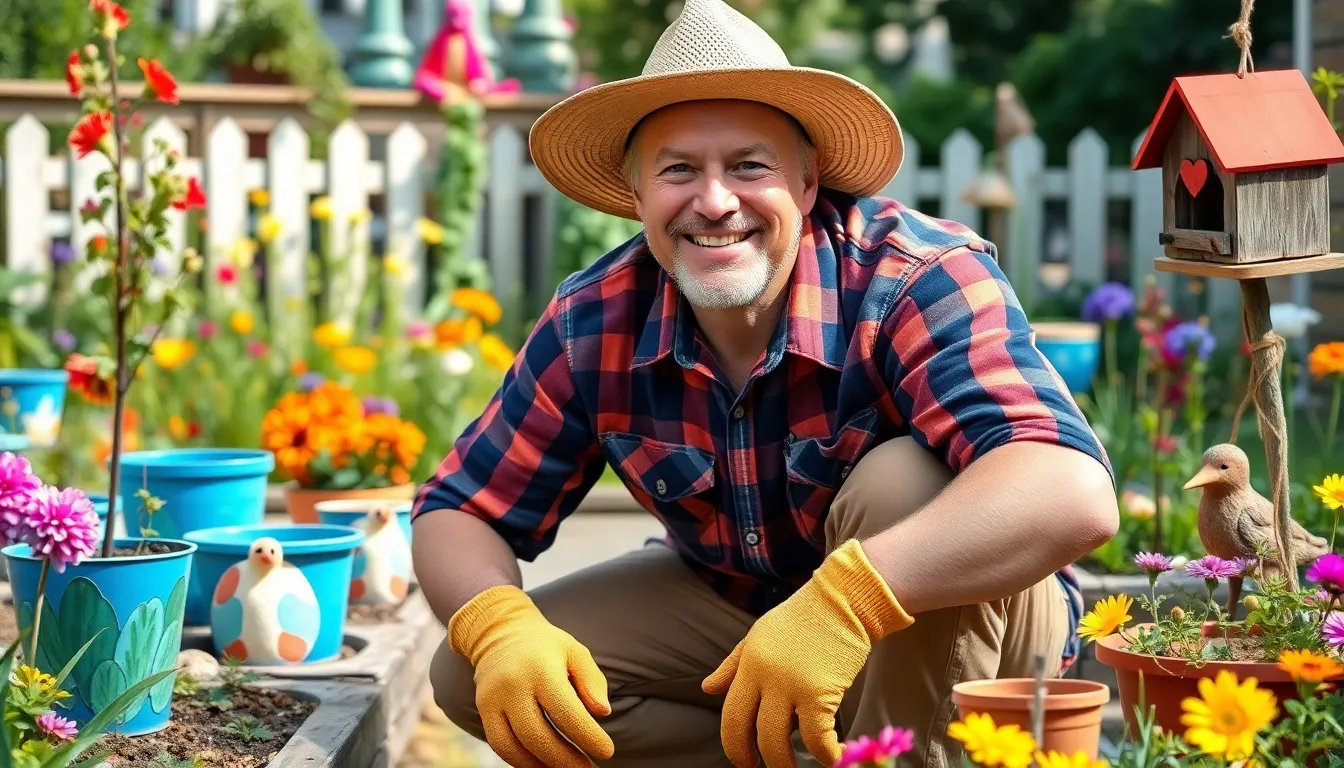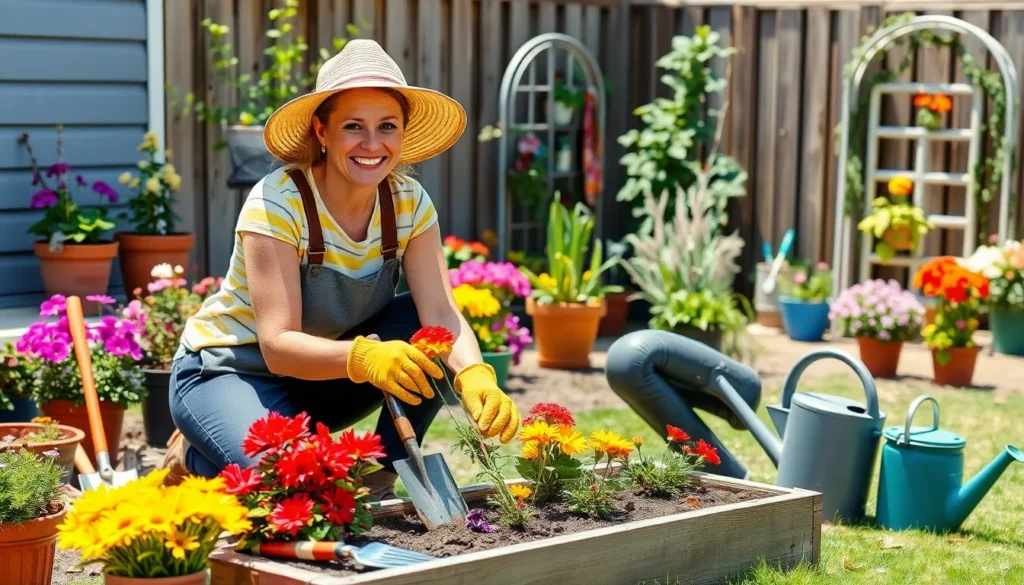Transforming a patch of dirt into a flourishing garden can feel like a Herculean task, but it doesn’t have to be! DIY garden projects are not just for the green-thumbed elite; they’re for anyone who wants to unleash their inner gardener and have a little fun while doing it. Imagine crafting your own raised beds or building a whimsical trellis—all while wearing your favorite gardening gloves and sipping on a refreshing lemonade. Who knew getting your hands dirty could be so rewarding?
Table of Contents
ToggleOverview of DIY Garden Projects
DIY garden projects offer a wide range of possibilities for transforming outdoor spaces. Gardening enthusiasts can explore options like building raised garden beds, creating decorative trellises, or designing unique planters. These projects cater to all skill levels, making it easy for both beginners and experienced gardeners to participate.
Engagement in DIY tasks allows individuals to express creativity through personalized designs. Projects can include painting pots in vibrant colors or constructing birdhouses to attract local wildlife. Material choices vary, with wood, stone, and recycled items commonly used to bring ideas to life.
Investing time in these activities leads to tangible results and enhances outdoor beauty. Raised beds provide better soil management, improving plant growth. Whimsical trellises add character, supporting climbing plants while contributing visual interest.
Budget-friendly options exist, encouraging cost-effective solutions for garden enhancement. Salvaging old materials for new purposes aligns with sustainable practices, promoting eco-friendly gardening. Enthusiasts often find joy in nurturing plants, watching them thrive in customized environments.
Communities may also benefit from collaborative garden projects. Neighbors can unite to create community gardens, fostering connections while cultivating fresh produce. Group DIY efforts allow participants to share resources and gardening knowledge.
DIY garden projects encourage creativity, community involvement, and sustainable practices. These initiatives empower individuals to engage actively in gardening, allowing everyone to enjoy the outdoors while enhancing their environment.
Benefits of DIY Garden Projects

DIY garden projects offer numerous advantages. These projects not only enhance outdoor spaces but also enrich the gardener’s experience.
Cost-Effectiveness
Many DIY garden projects prove economical. Creating raised beds or compost bins from recycled materials significantly lowers gardening costs. Individuals save money by avoiding expensive store-bought items while still achieving beautiful results. Budget-friendly options like container gardens or vertical gardens maximize small spaces without a hefty price tag. They also reduce reliance on professional landscaping services, allowing individuals to keep expenses in check. Ultimately, these projects enable a lush garden transformation at a fraction of the cost.
Personalization
Personalization shines through in DIY garden projects. Each gardener can design spaces that reflect their unique style and preferences. Customized garden decor, such as painted pots or hand-crafted birdhouses, adds character. Creativity flourishes when individuals choose colors, materials, and layouts that resonate with them. Tailored designs also allow for specific plant selections, catering to individual tastes and needs. This level of customization fosters a deeper connection with the garden, making it not just an outdoor space but a personal sanctuary.
Popular DIY Garden Project Ideas
Engaging in DIY garden projects offers a multitude of creative opportunities. These projects cater to all gardening enthusiasts, from beginners to seasoned pros.
Raised Garden Beds
Raised garden beds enhance soil drainage and provide better growing conditions. Individuals often construct these beds using wood, stone, or recycled materials. Creating a raised bed usually involves selecting a suitable location, measuring dimensions, and assembling the structure. This method allows for deeper soil management, leading to healthier plants. Enthusiasts can customize the design by adding attractive finishes or built-in plant supports.
Vertical Gardens
Vertical gardens maximize limited space, allowing for an impressive display of greenery. These gardens can be established on walls, fences, or even as free-standing structures. Common materials include pallets, trellises, and planters, which support a variety of plants, including herbs and flowers. Building a vertical garden typically involves securing the structure and arranging plants in a visually appealing manner. This project not only beautifies spaces but also encourages gardening in urban settings.
Garden Trellis
Garden trellises provide support for climbing plants, adding height and sophistication to any garden. Constructing a trellis can be achieved with materials such as wood, metal, or even sturdy branches. She can install trellises against walls, fences, or standalone in garden beds. Positioning trellises where they receive adequate sunlight ensures healthy plant growth. These structures enhance garden aesthetics and create a vertical dimension that increases overall interest in the landscape.
Essential Tools and Materials
DIY garden projects require specific tools and materials to enhance the gardening experience. These essentials simplify tasks and contribute to successfully transforming outdoor spaces.
Basic Tools Needed
Gardening begins with a few key tools. Shovels assist in breaking ground and planting seeds in soil. Trowels allow for precise digging and transplanting of young plants. Pruners enable maintenance of existing plants, ensuring overall health. Gloves protect hands from dirt and sharp objects, promoting a comfortable gardening session. A watering can or hose delivers necessary hydration, while a rake smooths surfaces. These tools form the foundation of any successful garden endeavor.
Recommended Materials
Choosing the right materials elevates garden projects. Wood serves as the primary choice for raised beds, providing durability and support. Metal or PVC pipes can facilitate vertical garden structures or trellises. Additionally, organic compost enriches soil, fostering plant growth. Mulch assists in moisture retention and weed control, essential for healthier plants. Stones or bricks create borders, enhancing the visual appeal. Selecting varied, budget-friendly materials facilitates creativity while ensuring sustainability in garden designs.
Tips for Success in DIY Garden Projects
Prioritize planning before starting any project. Detailed sketches help visualize the final look and ensure proper spacing for plants. Choose suitable locations that receive adequate sunlight and drainage. Assess the area to avoid damp spots, which can hinder plant growth.
Gather all necessary tools and materials to streamline the process. Essential tools include trowels, gloves, and watering cans. Using quality materials ensures durability; for instance, untreated wood resists rot better in raised beds than treated wood.
Start small, especially for beginners, by focusing on one project at a time. Successful completion of smaller tasks builds confidence and enhances skills. Select easy-to-grow plants, such as herbs or tomatoes, to achieve quick results and maintain motivation.
Incorporate sustainable practices to enrich the garden. Organizing compost bins transforms kitchen scraps into valuable nutrients. Utilizing native plants supports local wildlife and requires less maintenance.
Collaborate with friends or neighbors for shared projects. Working together allows for knowledge exchange and fosters community spirit. Group efforts often lead to new ideas and shared resources, reducing costs.
Evaluate progress regularly and adjust plans as necessary. Observing plant health can inform potential adjustments in care routines. Learning from experiences cultivates better gardening practices for future projects.
Celebrate achievements to maintain enthusiasm. Document progress through photos or gardening journals to reflect on growth over time. All these tips create an enjoyable and fruitful DIY gardening journey.
DIY garden projects offer a fulfilling way to enhance outdoor spaces and connect with nature. By embracing creativity and personalizing designs, individuals can cultivate gardens that reflect their unique styles. The joy of building something from scratch not only improves the aesthetics of a yard but also fosters a sense of accomplishment.
Whether it’s constructing raised beds or creating vertical gardens, each project contributes to a more sustainable and beautiful environment. Engaging in these activities can also strengthen community ties, as neighbors come together to share knowledge and resources.
With the right tools and a bit of planning, anyone can dive into these rewarding projects, transforming their gardens into vibrant havens.

